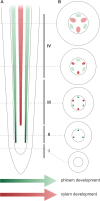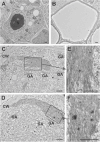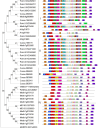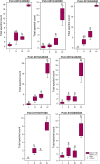Identification of phloem-specific proteinaSEOus structure heterogeneity in sieve element of Populus trichocarpa
- PMID: 40211162
- PMCID: PMC11983751
- DOI: 10.1186/s12870-025-06439-4
Identification of phloem-specific proteinaSEOus structure heterogeneity in sieve element of Populus trichocarpa
Abstract
Phloem, an exceptional plant vascular tissue, facilitates the transport of photoassimilates, RNAs, and other signaling substances from the leaves to the roots throughout the plant. Among the specialized phloem cells are the conductive sieve elements (SEs), which are unique in that they remain alive despite lacking several cell organelles, including the nucleus, plastids, and most mitochondria. These SEs contain a specific proteinaceous structure composed of phloem-specific proteins (P-proteins), whose function is not yet fully understood. Various P-proteins have been characterized in broad range of model species, including Arabidopsis thaliana, and reported in Fabaceae and Cucurbitaceae plants. To date, only one P-protein has been identified in the model tree species Populus trichocarpa. Given the presence of multiple P-protein encoding genes across numerous plant species, we hypothesized the existence of multiple such genes in the Populus genome. Our genomic analysis uncovered 12 genes being potential orthologues to one of A. thaliana P-protein - SEOR (sieve element occlusion-related) genes, which may contribute to the proteinaceous structures observed in differentiating sieve elements. Our transcriptomic and proteomic analyses confirmed the expression of at least seven of these genes, indicating that the protein structure visible in mature sieve elements in P. trichocarpa may be heterogeneous.
Keywords: Populus trichocarpa; P-protein; Phloem; SEO; SEOR; Sieve element.
© 2025. The Author(s).
Conflict of interest statement
Declarations. Ethics approval and consent to participate: Not applicable. Consent for publication: Not applicable. Competing interests: The authors declare no competing interests.
Figures







Similar articles
-
Non-dispersive phloem-protein bodies (NPBs) of Populus trichocarpa consist of a SEOR protein and do not respond to cell wounding and Ca2.PeerJ. 2018 Apr 17;6:e4665. doi: 10.7717/peerj.4665. eCollection 2018. PeerJ. 2018. PMID: 29682428 Free PMC article.
-
Molecular and phylogenetic characterization of the sieve element occlusion gene family in Fabaceae and non-Fabaceae plants.BMC Plant Biol. 2010 Oct 8;10:219. doi: 10.1186/1471-2229-10-219. BMC Plant Biol. 2010. PMID: 20932300 Free PMC article.
-
Sieve element occlusion (SEO) genes encode structural phloem proteins involved in wound sealing of the phloem.Proc Natl Acad Sci U S A. 2012 Jul 10;109(28):E1980-9. doi: 10.1073/pnas.1202999109. Epub 2012 Jun 25. Proc Natl Acad Sci U S A. 2012. PMID: 22733783 Free PMC article.
-
SEORious business: structural proteins in sieve tubes and their involvement in sieve element occlusion.J Exp Bot. 2014 Apr;65(7):1879-93. doi: 10.1093/jxb/eru071. Epub 2014 Mar 3. J Exp Bot. 2014. PMID: 24591057 Review.
-
Calcium powered phloem protein of SEO gene family "Forisome" functions in wound sealing and act as biomimetic smart materials.Plant Signal Behav. 2014;9(9):e29438. doi: 10.4161/psb.29438. Plant Signal Behav. 2014. PMID: 25763691 Free PMC article. Review.
References
-
- Evert RF. Esau’s Plant Anatomy: John Wiley & Sons. New Jersey: Ltd; 2006.
-
- Heo JO, Blob B, Helariutta Y. Differentiation of conductive cells: a matter of life and death. Curr Opin Plant Biol. 2017;35:23–9. - PubMed
-
- Aikman D. Phloem transport. Nature. 1974;252:760.
-
- Behnke HD, Sjolund RD. Sieve Elements: comparative structure, introduction and development. Berlin: Springer; 1990.
MeSH terms
Substances
Grants and funding
LinkOut - more resources
Full Text Sources

